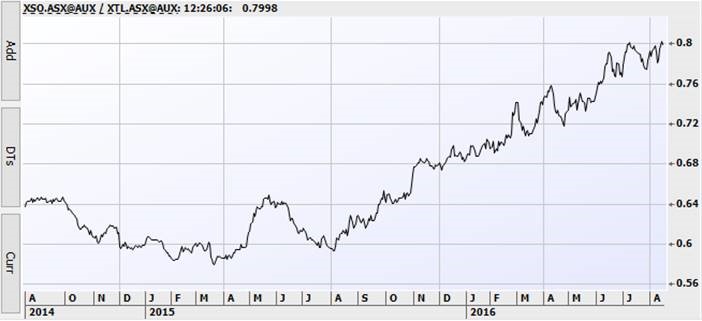Small is beautiful for now

Mason Stevens
The following table shows the annualized total returns of selected Australian equity indices over various time periods ended 12 August 2016.
[Returns.PNG]
One area of the market that has consistently performed well over the past five years is the ASX Midcap 50, which comprises the bottom half of the ASX 100 index. As can be seen from the table, it has significantly outperformed the ASX 50 index over 1-year, 3-year and 5-year periods. Some fund managers deliberately overweight Midcap 50 stocks as a core part of their investment process, as they try to exploit what they believe to be a persistent market inefficiency.
The top 10 stocks by index weight in the Midcap 50 index are Aristocrat Leisure, Fortescue Metals, Cochlear, Treasury Wine Estates, Duet Group, Tatts Group, ResMed, Challenger, Vocus Communications and Healthscope.
While most investors are familiar with these names they, for whatever reason, often omit them from their portfolios, along with other Midcap 50 stocks. In other words, there are a number of successful, well-researched companies that are habitually under-owned by the average investor.
Two other stocks in the Midcap 50 index are JB HiFi and Harvey Norman. Both stocks appeared in our "GARY" list of stocks - stocks with Growth and a Reasonable Yield. JB HiFi reported a stronger-than-expected FY16 result yesterday, with EPS up 11.5%, the final dividend (fully franked) up 19.4%, and a continuation of the company's on-market share buy-back.
Other Midcap 50 stocks include TPG Telecom, Domino Pizza, REA Group, Magellan Financial Group, Carsales.Com, Sirtex Medical, Boral, and DuluxGroup.
Most large companies in the ASX 50 are finding it difficult to generate much EPS growth over the next couple of years. In the case of the banks, credit quality is deteriorating, and further capital raisings will be needed. Yet many investors remain overweight the large cap stocks and are missing out on the stronger EPS growth available in the mid-to-small cap end of the market. Investors should regularly review their portfolios to make sure that they have the kinds of exposures that are suitable for the times and that they are comfortable with. It may be appropriate to trim some large cap exposures and reinvest into some ex-50 stocks.
There are always some relatively undiscovered stock opportunities to be had in the small cap space. It is the least efficient part of the market and the area where active management can add the most value. However, with smaller size comes higher risk. Smaller companies often lack the financial strength and diversity of their larger peers. The Midcap 50 provides a good "halfway house" of growth and financial safety.
The Australian Real Estate Investment Trusts (A-REITs) are often regarded as a separate asset class and have been particularly strong performers over the past five years as bond yields fell sharply. However, they were chronic underperformers through the GFC period and will be vulnerable to correction when bond yields eventually rise.
The 10-year performance numbers in the table provide a salutary reminder that over long enough periods of time the performance differences tend to even out (even for the Midcap 50).
Although small is beautiful right now, small caps tend to be more vulnerable when overvalued equity markets correct, with investors preferring bigger, safer names. Although there are some small-cap stocks still worth owning, such as the four world-beating Australian tech stocks we wrote about recently (ACX, ALU, HSN, and FLN), we think the quality mid-cap space provides (in a relative sense) the best of both worlds, growth and financial safety.
Article contributed by Mason Stevens: (VIEW LINK)
2 topics
9 stocks mentioned

Responsible for identifying domestic and international equity investment opportunities. 25 years of financial markets experience as an equity strategist, economist, analyst, portfolio manager and consultant.
Expertise

Responsible for identifying domestic and international equity investment opportunities. 25 years of financial markets experience as an equity strategist, economist, analyst, portfolio manager and consultant.

